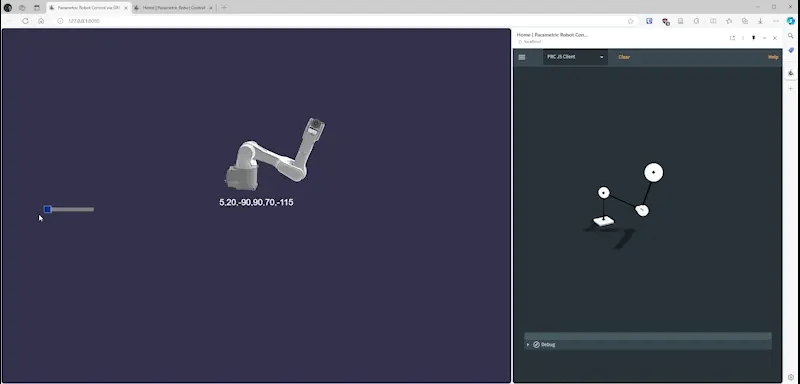
From Scratch
The following steps are only necessary if you want to build everything from scratch!
To work with gRPC in Javascript, you need to install the
google-protobuf and the grpc-web package. This is best done via the package.json file, assuming that you use npm.json{ "version": "1.0.0", "name": "parametric-robot-control", "private": true, "dependencies": { "google-protobuf": "~3.21.4", "grpc-web": "~1.5.0" }, "devDependencies": { "terser-webpack-plugin": "^5.3.10", "webpack": "~5.94.0", "webpack-cli": "~5.1.4" } }
Create a webpack configuration as below.
javascriptconst TerserPlugin = require("terser-webpack-plugin"); const path = require('path'); module.exports = { mode: "production", entry: "./export.js", devtool: "source-map", optimization: { minimize: false, minimizer: [ new TerserPlugin({ terserOptions: { keep_classnames: true, keep_fnames: true } }) ] }, output: { path: path.resolve(__dirname, 'dist'), filename: 'prc.js', globalObject: 'this', library: { name: 'prc', type: 'umd', }, } };
Then you can automatically generate Javascript code with that command:
javascriptprotoc -I=. prc.proto \ --js_out=import_style=commonjs,binary:. \ --grpc-web_out=import_style=commonjs,mode=grpcwebtext:.
This gets you the following files:
prc_grpc_web_pb.js
prc_pb.js
The
exports.js file exports the relevant classes.You can also generate Typescript files which will help with auto-completion, see here ‣
Use the following commands to install the packages and create the
prc.js file in the dist directory via webpack.bashnpm install npx webpack
If you want to test it on a web server, you could run the following command
bashnpx http-server
Integration
Here you should either have the
prc.js file from the steps above or simply from the download section. Create a new file and call it run_prc.js. Place it in the root directory.We define a simple HTML page that references the libraries.
html<!DOCTYPE html> <html lang="en"> <head> <meta charset="UTF-8"> <title>Parametric Robot Control via GRPC-Web</title> <script src="./dist/prc.js"></script> <script src="./run_prc.js" type="module"></script> </head> <body> <p>Simulation feedback:</p> <div id="feedback-text"></div> </body> </html>
In the
run_prc.js file we first set up the client.javascriptvar server = 'https://localhost:5001'; var client = new prc.ParametricRobotControlServicePromiseClient(server, null, null);
Ping the PRC Server and choose a unique ID for your robot
javascriptvar pingRequest = new prc.Ping() .setPayload('Hello'); var response = await client.sendPing(pingRequest, {}); var robotID = 'PRC JS Client';
You can then setup your robotic system. The robot driver class and preset robot class reference existing drivers/robots in PRC.
javascriptvar setupRobotRequest = new prc.SetupRobotRequest() .setClientId(robotID) .setSoftwareVersion('0.1') .setRobotSetup(new prc.Robot() .setFriendlyId('KUKA KR10') .setRobotDriverClass('KUKA.KSS_KRL_Driver') .setPresetRobotClass('KUKA.KUKA_KR610R11002') .setInitialBase(new prc.Base() .setBaseFrame(new prc.CartesianPosition() .setCs(new prc.CoordinateSystem() .setOrigin(new prc.Vector3() .setX(0) .setY(0) .setZ(0) ) .setXAxis(new prc.Vector3() .setX(1) .setY(0) .setZ(0) ) .setYAxis(new prc.Vector3() .setX(0) .setY(1) .setZ(0) ) ) ) ) ); setupRobotRequest.getRobotSetup().getToolDictionaryMap() .set('0', new prc.Tool() .setToolId('0') .setToolType(prc.FrameType.FIXED) .setTcp(new prc.CartesianPosition() .setCs(new prc.CoordinateSystem() .setOrigin(new prc.Vector3() .setX(0) .setY(0) .setZ(0)) .setXAxis(new prc.Vector3() .setX(1) .setY(0) .setZ(0)) .setYAxis(new prc.Vector3() .setX(0) .setY(1) .setZ(0)) ) ) ); var setupRobotReply = new prc.SetupRobotReply(); setupRobotReply = await client.setupRobot(setupRobotRequest, {});
In order to get feedback, we establish the feedback stream.
javascriptvar stream = client.subscribeRobotFeedback(new prc.SubscribeRobotFeedbackRequest().setId(robotID), {}); stream.on('data', function(response) { console.log(response.getStatus()); }); stream.on('status', function(status) { console.log(status.code); console.log(status.details); console.log(status.metadata); }); stream.on('end', function(end) {});
Now define your movements and group them in
MotionGroup objects.javascriptvar ptpMotion1 = new prc.MotionCommand() .setAxisMotion(new prc.AxisMotion() .setTarget(new prc.JointTarget() .setAxisValuesList([-45, -90, 90, 0, 0, 0]) .setSpeedList([0.1]) )); var ptpMotion2 = new prc.MotionCommand() .setAxisMotion(new prc.AxisMotion() .setTarget(new prc.JointTarget() .setAxisValuesList([45, -90, 90, 0, 0, 0]) .setSpeedList([0.1]) )); var ptpMotionGroup = new prc.MotionGroup() .setCommandsList([ptpMotion1, ptpMotion2]) .setInterpolation('C_PTP') .setMotionGroupType(prc.MotionGroupType.PTP);
Next, put the motion groups into a task. You get the default
RobotSettings from the initial setupRobot call. As they are a dictionary, you can edit them easily.javascriptvar addTask = new prc.AddRobotTaskRequest() .setId(robotID) .setRobotTask(new prc.Task() .setName('Task') .setType(prc.TaskType.SIMULATE_AND_EXECUTE_TASK) .setPayloadList([new prc.TaskPayload() .setMotionGroupTask(ptpMotionGroup) ]) ) .setRobotSettings(setupRobotReply.getRobotSettings()); var addTaskReply = await client.addRobotTask(addTask, {})
You can go through the simulation through the
GetStimulatedRobotState call. In the example below, it iterates by 4% every 400ms.javascriptvar i = 0; while (i < 100) { i += 4; var robotState = new prc.GetSimulatedRobotStateRequest() .setAsyncStreamUpdate(false) .setId(robotID) .setNormalizedState(i / 100.0); var robotStateResponse = await client.getSimulatedRobotState(robotState, {}); await new Promise(r => setTimeout(r, 400)); }
The full code is available in the GitHub repository. The example is expanded with a 3D view that uses the BabylonJS library.
PRC.Integrations
jbraumann • Updated Nov 25, 2025
